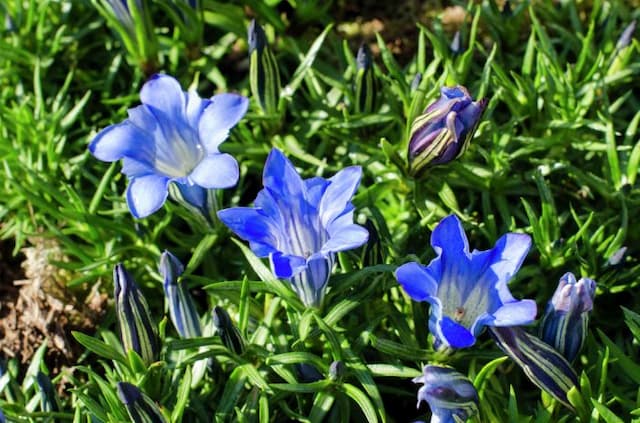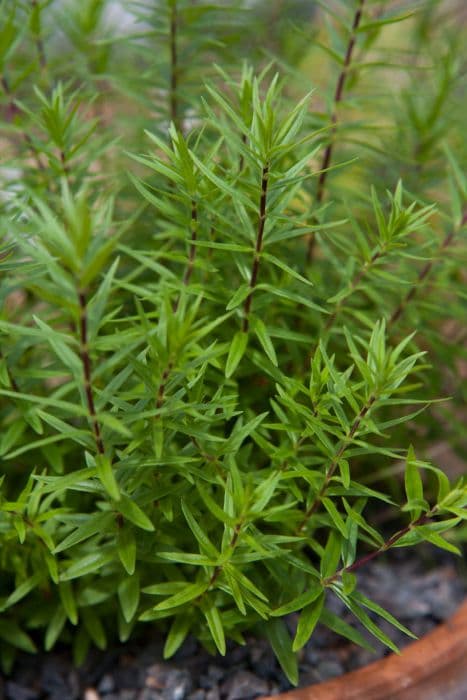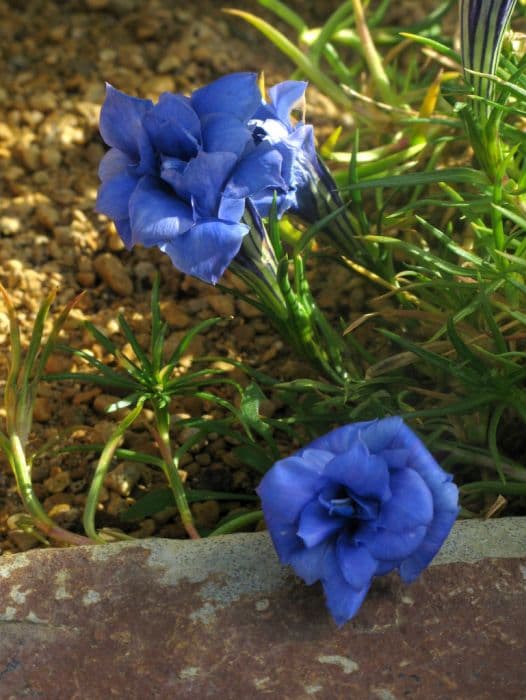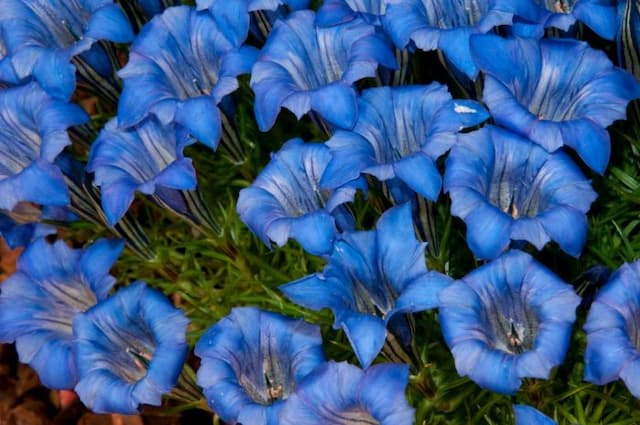Marsh gentian Gentiana pneumonanthe






ABOUT
The Marsh Gentian is a perennial plant characterized by its eye-catching, bright blue flowers. These flowers have a trumpet-like shape with five pointed lobes, resembling stars, and are known for their intense azure hue which stands out against the lush greenery. The plant forms a basal rosette of narrow, lance-shaped leaves that are green and sometimes have a slightly lighter color beneath. They are arranged in a spiraling pattern around the stem, which supports the striking flowers. The blooms typically appear at the apex of the stem, singly or in small clusters, creating a visually appealing contrast. The overall look of the Marsh Gentian is of a delicate and vibrant plant with standout blue flowers that can add a splash of color to the environments it inhabits.
About this plant
 Names
NamesFamily
Gentianaceae
Synonyms
Marsh Gentian, Bog Gentian
Common names
Gentiana pneumanthe, Gentiana pneumonanthe var. pneumonanthe, Gentianella pneumonanthe.
 Toxicity
ToxicityTo humans
Gentiana pneumonanthe, commonly known as Marsh Gentian, is not generally considered toxic to humans. There is a lack of significant evidence indicating that consumption of this plant causes harm. However, as with any plant, individual allergic reactions or sensitivities can occur. If Marsh Gentian is ingested in large quantities, it could potentially lead to gastrointestinal upset due to its bitter properties. In any case of suspected plant poisoning, medical attention should be sought.
To pets
Marsh Gentian is not typically listed as a toxic plant for pets. As with humans, this plant is unlikely to cause significant problems if ingested by pets in small quantities. However, due to its bitter taste, it might lead to mild gastrointestinal upset, such as vomiting or diarrhea, if ingested in large amounts. Always be cautious and consult a veterinarian if you suspect your pet has ingested any part of a plant and is showing signs of distress.
 Characteristics
CharacteristicsLife cycle
Perennials
Foliage type
Deciduous
Color of leaves
Green
Flower color
Blue
Height
1 feet (30 cm)
Spread
1 feet (30 cm)
Plant type
Herb
Hardiness zones
5
Native area
Europe
Benefits
 General Benefits
General Benefits- Ecosystem support: Gentiana pneumonanthe, commonly known as Marsh Gentian, is a food plant for the caterpillars of certain butterflies, thereby playing a role in supporting local ecosystems and biodiversity.
- Ornamental value: Marsh Gentian is valued for its vivid blue flowers which can enhance the aesthetic appeal of gardens and natural landscapes.
- Conservation importance: Being a species of conservation concern in some areas, preserving Marsh Gentian can contribute to habitat conservation and the protection of rare species.
- Soil stabilization: This plant can help stabilize soil in wetland environments, thus preventing erosion and maintaining the health of delicate ecosystems.
- Educational interest: Marsh Gentian is often used in educational settings to teach about plant ecology, conservation efforts, and the importance of wetland habitats.
- Pollinator attraction: The flowers of Marsh Gentian are known to attract bees and other pollinators, which are essential for the pollination of many plants and crops.
 Medical Properties
Medical Properties- Anti-inflammatory: Gentiana pneumonanthe has been traditionally used for its potential to reduce inflammation.
- Antimicrobial: There are indications that the plant may have antimicrobial properties, which could help in fighting certain infections.
- Hepatoprotective: The herb has been used to protect the liver and improve liver function.
- Choleretic: Gentiana pneumonanthe has been suggested to increase bile production, aiding in digestion and liver function.
- Antioxidant: It may contain compounds with antioxidant effects that help in protecting cells from oxidative stress.
- Immunomodulatory: The plant may influence the immune system, although the specifics of this action are not well defined.
 Air-purifying Qualities
Air-purifying QualitiesThis plant is not specifically known for air purifying qualities.
 Other Uses
Other Uses- Gentiana pneumonanthe, commonly known as Marsh Gentian, has been used as a blue dye for fabrics, given its distinct blue color.
- The flower of the Marsh Gentian can be used in the preparation of certain traditional liqueurs and bitters, contributing to their unique flavors.
- In horticulture, Marsh Gentian is appreciated for its ornamental value, often being cultivated in botanical gardens for its striking blue flowers.
- The roots of Marsh Gentian have historically been used to curdle milk in cheese-making processes in certain cultures.
- This plant can be used in educational settings as a subject for botanical studies due to its unique morphology and pollination mechanisms.
- Marsh Gentian can be incorporated into nature-inspired art projects, such as botanical prints or natural dyes for painting.
- Due to its attractiveness to pollinators, Marsh Gentian is sometimes used in butterfly gardens to attract and support local butterfly populations.
- The flowers can be used in the creation of eco-friendly confetti for celebrations, as it is biodegradable and less harmful to the environment than plastic confetti.
- Marsh Gentian has been utilized in landscape restoration projects to help maintain biodiversity and restore native plant communities in wetlands.
- In some regions, Marsh Gentian is used in traditional culinary practices, where the bitter taste of the plant is incorporated into certain dishes for flavor enhancement.
Interesting Facts
 Feng Shui
Feng ShuiThe Marsh Gentian is not used in Feng Shui practice.
 Zodiac Sign Compitability
Zodiac Sign CompitabilityThe Marsh Gentian is not used in astrology practice.
 Plant Symbolism
Plant Symbolism- Persistence: Gentiana pneumonanthe, commonly known as the Marsh Gentian, is famed for its resilience and ability to thrive in challenging environments, symbolizing determination and the will to overcome difficulties.
- Healing: With its historical use in medicinal remedies, the Marsh Gentian represents the power of healing and the importance of health and well-being.
- Victory: Its striking blue flowers that stand out in its natural habitat have made it a symbol of triumph and victory, often connected to narratives of overcoming obstacles.
- Attractiveness: The beauty of the Marsh Gentian's blooms is suggestive of attraction and charm, symbolizing an alluring personality or the enchanting nature of something.
- Love: In some folklore, giving someone a Marsh Gentian is a sign of unconditional love, representing deep affection and devotion.
 Water
WaterThe Marsh Gentian requires consistent moisture, so watering should be done carefully to maintain damp soil without causing waterlogging. Typically, water the plant with about one gallon per week, adjusting for rainfall and evaporation. In hotter, dryer conditions, increase the frequency to keep the soil consistently moist, but be cautious not to overwater as this can lead to root rot. During the winter when the plant is dormant, reduce watering to prevent the soil from becoming soggy.
 Light
LightMarsh Gentian thrives in full sun to partial shade, so it's best to plant it in a spot where it will receive plenty of light but be shielded from the intense midday sun. An optimal location would be where it can enjoy the morning sun and then be protected during the hot afternoon hours, or in an area that receives dappled sunlight throughout the day.
 Temperature
TemperatureMarsh Gentian does well in cooler climates and can withstand temperatures down to around 20°F, but it will not survive in extreme heat. The ideal temperature range for this plant is between 50°F and 70°F. Avoid placing the Marsh Gentian in locations where summer temperatures consistently exceed 80°F as this can stress the plant and affect its growth and flowering.
 Pruning
PruningPruning the Marsh Gentian is not typically necessary for health, but it can be done to maintain shape and remove any dead or damaged stems. Prune after blooming to encourage new growth for the next season, usually cutting back the stems by just a few inches. Deadheading spent flowers can also promote further blooming.
 Cleaning
CleaningAs needed
 Soil
SoilMarsh Gentian thrives in a soil mix that is well-drained, acidic to neutral in pH (ideally pH 5.0 to 7.0), and rich in organic matter. A mixture of peat, loamy soil, and sand in equal parts can create an ideal growing medium. The soil should be kept moist but not waterlogged to mimic its natural boggy habitat.
 Repotting
RepottingMarsh Gentian does not typically require frequent repotting and can be repotted every two to three years or when it has outgrown its current pot. It's important to handle the roots carefully during repotting to minimize disturbance and stress to the plant.
 Humidity & Misting
Humidity & MistingMarsh Gentian prefers moderate to high humidity conditions, but it is adaptable and can tolerate lower humidity levels as long as the soil moisture is maintained consistently. Aim for a humidity level of 50-70% for optimal growth.
 Suitable locations
Suitable locationsIndoor
Provide bright light, keep the soil moist, and ensure high humidity.
Outdoor
Plant in moist, rich, well-drained soil; partial shade.
Hardiness zone
3-7 USDA
 Life cycle
Life cycleThe Marsh Gentian (Gentiana pneumonanthe) begins its life cycle as a seed, typically germinating in damp, acidic soils often found in wetlands or marshes. After germination, it enters the seedling stage, where it starts to develop its root system and first leaves. As it matures into the vegetative stage, it forms a rosette of lance-shaped leaves at the base and elongated, upright stems. During the flowering stage, usually between July and September, the plant exhibits bright blue, funnel-shaped flowers that are pollinated by insects, particularly bumblebees. After pollination, the plant produces dry capsule fruits containing numerous small seeds. Finally, in the senescence stage, the above-ground parts of the plant wither away at the end of the growing season, completing its life cycle, while the seeds disperse to give rise to new plants in the following seasons.
 Propogation
PropogationPropogation time
Spring-Early Summer
Gentiana pneumonanthe, commonly known as Marsh Gentian, is typically propagated by seed. To propagate Marsh Gentian by seed, the best time is either in autumn or in early spring to allow for natural temperature fluctuations to break seed dormancy. Seeds should be sown on the surface of a well-draining soil mix and lightly pressed into the substrate, as they require light to germinate. Keep the soil moist but not waterlogged, and expose them to cool temperatures, typically between 50 to 70 degrees Fahrenheit (approximately 10 to 21 degrees Celsius). Germination can be slow and irregular, often taking a few weeks to months. Once seedlings are large enough to handle, they can be transplanted into individual pots and grown on until they are ready to be planted out in their final position.









